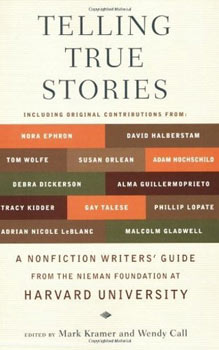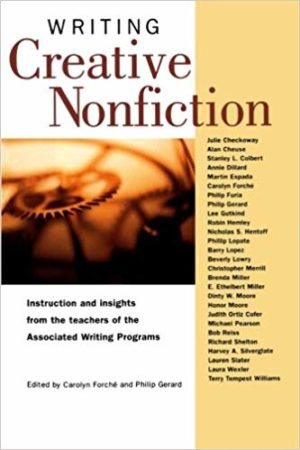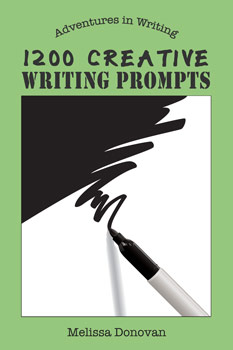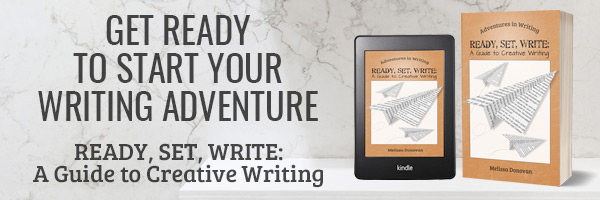Writing Fiction A Guide To Narrative Craft

Try your hand at writing creative nonfiction.
Here at Writing Forward, we're primarily interested in three types of creative writing: poetry, fiction, and creative nonfiction.
With poetry and fiction, there are techniques and best practices that we can use to inform and shape our writing, but there aren't many rules beyond the standards of style, grammar, and good writing. We can let our imaginations run wild; everything from nonsense to outrageous fantasy is fair game for bringing our ideas to life when we're writing fiction and poetry.
However, when writing creative nonfiction, there are some guidelines that we need to follow. These guidelines aren't set in stone; however, if you violate them, you might find yourself in trouble with your readers as well as the critics.
What is Creative Nonfiction?

Telling True Stories (aff link).
What sets creative nonfiction apart from fiction or poetry?
For starters, creative nonfiction is factual. A memoir is not just any story; it's a true story. A biography is the real account of someone's life. There is no room in creative nonfiction for fabrication or manipulation of the facts.
So what makes creative nonfiction writing different from something like textbook writing or technical writing? What makes it creative?
Nonfiction writing that isn't considered creative usually has business or academic applications. Such writing isn't designed for entertainment or enjoyment. Its sole purpose is to convey information, usually in a dry, straightforward manner.
Creative nonfiction, on the other hand, pays credence to the craft of writing, often through literary devices and storytelling techniques, which make the prose aesthetically pleasing and bring layers of meaning to the context. It's pleasurable to read.
According to Wikipedia:
Creative nonfiction (also known as literary or narrative nonfiction) is a genre of writing truth which uses literary styles and techniques to create factually accurate narratives. Creative nonfiction contrasts with other nonfiction, such as technical writing or journalism, which is also rooted in accurate fact, but is not primarily written in service to its craft.
Like other forms of nonfiction, creative nonfiction relies on research, facts, and credibility. While opinions may be interjected, and often the work depends on the author's own memories (as is the case with memoirs and autobiographies), the material must be verifiable and accurately reported.
Creative Nonfiction Genres and Forms
There are many forms and genres within creative nonfiction:
- Memoir
- Autobiography and biography
- Personal essays
- Literary journalism
- Speeches
- Journaling
- Any topical material, such as food or travel writing, self-development, art, or history, can be creatively written with a literary angle
Let's look more closely at a few of these nonfiction forms and genres:
Memoirs: A memoir is a long-form (book-length) written work. It is a firsthand, personal account that focuses on a specific experience or situation. One might write a memoir about serving in the military or struggling with loss. Memoirs are not life stories, but they do examine life through a particular lens. For example, a memoir about being a writer might begin in childhood, when the author first learned to write. However, the focus of the book would be on writing, so other aspects of the author's life would be left out, for the most part.
Biographies and autobiographies: A biography is the true story of someone's life. If an author composes their own biography, then it's called an autobiography. These works tend to cover the entirety of a person's life, albeit selectively.
Literary journalism: Journalism sticks with the facts while exploring the who, what, where, when, why, and how of a particular person, topic, or event. Biographies, for example, are a genre of literary journalism, which is a form of nonfiction writing. Traditional journalism is a method of information collection and organization. Literary journalism also conveys facts and information, but it honors the craft of writing by incorporating storytelling techniques and literary devices. Opinions are supposed to be absent in traditional journalism, but they are often found in literary journalism, which can be written in long or short formats.
Personal essays are a short form of creative nonfiction that can cover a wide range of styles, from writing about one's experiences to expressing one's personal opinions. They can address any topic imaginable. Personal essays can be found in many places, from magazines and literary journals to blogs and newspapers. They are often a short form of memoir writing.
Speechescan cover a range of genres, from political to motivational to educational. A tributary speech honors someone whereas a roast ridicules them (in good humor). Unlike most other forms of writing, speeches are written to be performed rather than read.
Journaling: A common, accessible, and often personal form of creative nonfiction writing is journaling. A journal can also contain fiction and poetry, but most journals would be considered nonfiction. Some common types of written journals are diaries, gratitude journals, and career journals (or logs), but this is just a small sampling of journaling options.

Writing Creative Nonfiction (aff link).
Any topic or subject matter is fair game in the realm of creative nonfiction. Some nonfiction genres and topics that offer opportunities for creative nonfiction writing include food and travel writing, self-development, art and history, and health and fitness. It's not so much the topic or subject matter that renders a written work as creative; it's how it's written — with due diligence to the craft of writing through application of language and literary devices.
Guidelines for Writing Creative Nonfiction
Here are six simple guidelines to follow when writing creative nonfiction:
- Get your facts straight. It doesn't matter if you're writing your own story or someone else's. If readers, publishers, and the media find out you've taken liberties with the truth of what happened, you and your work will be scrutinized. Negative publicity might boost sales, but it will tarnish your reputation; you'll lose credibility. If you can't refrain from fabrication, then think about writing fiction instead of creative nonfiction.
- Issue a disclaimer. A lot of nonfiction is written from memory, and we all know that human memory is deeply flawed. It's almost impossible to recall a conversation word for word. You might forget minor details, like the color of a dress or the make and model of a car. If you aren't sure about the details but are determined to include them, be upfront and include a disclaimer that clarifies the creative liberties you've taken.
- Consider the repercussions. If you're writing about other people (even if they are secondary figures), you might want to check with them before you publish your nonfiction. Some people are extremely private and don't want any details of their lives published. Others might request that you leave certain things out, which they want to keep private. Otherwise, make sure you've weighed the repercussions of revealing other people's lives to the world. Relationships have been both strengthened and destroyed as a result of authors publishing the details of other people's lives.
- Be objective. You don't need to be overly objective if you're telling your own, personal story. However, nobody wants to read a highly biased biography. Book reviews for biographies are packed with harsh criticism for authors who didn't fact-check or provide references and for those who leave out important information or pick and choose which details to include to make the subject look good or bad.
- Pay attention to language. You're not writing a textbook, so make full use of language, literary devices, and storytelling techniques.
- Know your audience. Creative nonfiction sells, but you must have an interested audience. A memoir about an ordinary person's first year of college isn't especially interesting. Who's going to read it? However, a memoir about someone with a learning disability navigating the first year of college is quite compelling, and there's an identifiable audience for it. When writing creative nonfiction, a clearly defined audience is essential.
Are you looking for inspiration?
Check out these creative nonfiction writing ideas.
Ten Creative Nonfiction Writing Prompts and Projects
The prompts below are excerpted from my book, 1200 Creative Writing Prompts, which contains fiction, poetry, and creative nonfiction writing prompts. Use these prompts to spark a creative nonfiction writing session.

1200 Creative Writing Prompts (aff link).
- What is your favorite season? What do you like about it? Write a descriptive essay about it.
- What do you think the world of technology will look like in ten years? Twenty? What kind of computers, phones, and other devices will we use? Will technology improve travel? Health care? What do you expect will happen and what would you like to happen?
- Have you ever fixed something that was broken? Ever solved a computer problem on your own? Write an article about how to fix something or solve some problem.
- Have you ever had a run-in with the police? What happened?
- Have you ever traveled alone? Tell your story. Where did you go? Why? What happened?
- Let's say you write a weekly advice column. Choose the topic you'd offer advice on, and then write one week's column.
- Think of a major worldwide problem: for example, hunger, climate change, or political corruption. Write an article outlining a solution (or steps toward a solution).
- Choose a cause that you feel is worthy and write an article persuading others to join that cause.
- Someone you barely know asks you to recommend a book. What do you recommend and why?
- Hard skills are abilities you have acquired, such as using software, analyzing numbers, and cooking. Choose a hard skill you've mastered and write an article about how this skill is beneficial using your own life experiences as examples.
Do You Write Creative Nonfiction?
Have you ever written creative nonfiction? How often do you read it? Can you think of any nonfiction forms and genres that aren't included here? Do you have any guidelines to add to this list? Are there any situations in which it would be acceptable to ignore these guidelines? Got any tips to add? Do you feel that nonfiction should focus on content and not on craft? Leave a comment to share your thoughts, and keep writing.

Writing Fiction A Guide To Narrative Craft
Source: https://www.writingforward.com/creative-writing/writing-creative-nonfiction
Posted by: thalerpappin.blogspot.com

0 Response to "Writing Fiction A Guide To Narrative Craft"
Post a Comment